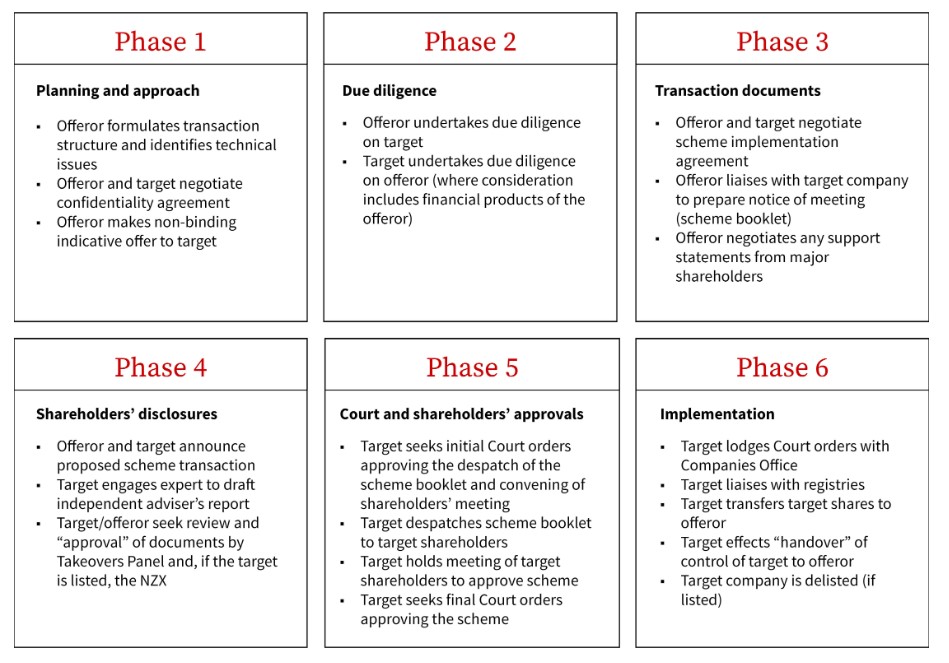In the third article of our Takeover series, we look at how a scheme of arrangement can be used to acquire control of a New Zealand Code Company.
Read the previous articles in this series:
- Part 1: New Zealand takeover laws; what you need to know
- Part 2: Takeover Offer v Scheme of Arrangement – Structuring a friendly acquisition
What is a scheme of arrangement?
Schemes of arrangement are becoming more common as the preferred way in which ‘takeovers’ of Code Companies are effected.
A scheme of arrangement is a procedure under Part 15 of the Companies Act that allows a company to reorganise its share capital with the approval of shareholders and the Court.
A scheme can be used to effect a wide range of corporate restructures. The most common use of the scheme procedure is to effect the same outcome as a takeover offer by transferring the majority or even all shares in the target company to the offeror in return for consideration paid by the offeror to the target shareholders.
Overview of a scheme of arrangement
Under a scheme of arrangement, the offeror and target (through its Board) must first reach agreement to propose the scheme to target shareholders, following which approvals are sought from both target shareholders and the Court.
Some of the key phases and steps in a scheme of arrangement are shown below:

Key steps in a scheme of arrangement
Initial approach
The first step in the scheme process will typically involve the offeror approaching the target company with an indicative offer to propose a scheme under which the offeror would acquire 100% of the target company.
Due diligence
If the target company is amenable to the offeror’s indicative offer, the target company will typically grant the offeror a period of due diligence (either on an exclusive or non-exclusive basis) so that the offeror can confirm its interest in the target company and the amount of consideration to be offered by the offeror. In a listed company, due diligence may be fairly limited, as significant reliance is normally placed on the continuous disclosure obligations of the listed target.
If the proposed consideration includes financial products in the offeror, the target company may undertake some due diligence on the offeror to confirm the value of those financial products.
Scheme implementation agreement
Before the scheme proposal is publicly announced, the offeror and the target company will typically enter into a ‘scheme implementation agreement’ which:
- sets out the terms of the scheme and commits the offeror and the target company to the scheme transaction;
- obliges the target company to propose the scheme to target shareholders, and normally commits the target directors to recommend that target shareholders vote in favour of the scheme in the absence of a superior proposal; and
- sets out how the offeror and target company will work together throughout the scheme approval process.
The scheme implementation agreement will typically contain ‘deal protection mechanisms’ such as:
- ‘no shop’, ‘no talk’ and ‘no due diligence’ obligations on the target company to seek to prevent the target company from proactively generating rival offers;
- a notification and matching right for the offeror to be notified of, and have the opportunity to match, any third party offer for control of the target company before the target company directors may make any recommendation of that third party offer to target shareholders; and
- a break fee payable by the target company to the offeror if a third party is successful in obtaining control of the target company or if the target company directors change their recommendation to vote in favour of the scheme in certain circumstances.
The scheme is typically publicly announced for the first time when the scheme implementation agreement is finalised. That announcement will usually attach a full copy of the scheme implementation agreement.
The most common use of the scheme procedure is to effect the same outcome as a takeover offer
Shareholders’ disclosure and approval process
After the scheme is publicly announced, in order to seek shareholder approval, the target company (with the assistance of the offeror) prepares a disclosure document known as a ‘scheme booklet’.
The scheme booklet generally contains all information known to the target company and the offeror that is material to a target shareholder’s decision as to how to vote on the proposed scheme. The scheme booklet will typically include an independent adviser’s report on the merits of the transaction.
Although Takeovers Panel “approval” is not required for a scheme, the target company should seek the Takeovers Panel’s approval of the draft scheme documents considering that the Takeovers Panel can object to a scheme at Court. The target company should lodge the draft scheme documents with the Takeovers Panel for review, which will normally take a couple of weeks. If the Takeovers Panel is satisfied with the draft scheme documents, it will provide a letter stating that it is minded to issue a no-objection statement (discussed further below).
If the target company (or potentially the offeror) is listed, the draft scheme documents should also be sent to the NZX for review within the prescribed timeframes.
The final draft scheme documents and the letter from the Takeovers Panel should be provided to the Court for the initial Court hearing. The purpose of the initial Court hearing is to seek the Court’s approval to send the scheme booklet to all target shareholders and to convene a meeting of target shareholders to vote on the scheme.
The target company will then hold the shareholder vote on whether to approve the scheme at the scheme meeting.
For the scheme to be approved, target shareholders must approve the scheme by resolution of:
- 75% of the votes cast in each interest class[1]; and
- a simple majority of all votes on issue (whether voted or not).
Court approval and implementation
If the shareholders do not approve the scheme, it will fail. There is no “middle ground” position or ability to continue pursuing the scheme as part of the same process but just with those shareholders that voted in favour.
If target shareholders approve the scheme, the target company will then seek final Court orders approving the scheme.
The Court may not approve the scheme unless:
- the Court is satisfied that the shareholders of the target company will not be adversely affected by the use of the scheme rather than the Takeovers Code to effect the change involving the Code company; or
- the applicant has filed a statement from the Takeovers Panel indicating that the Takeovers Panel has no objection to an order being made to approve the scheme.
The target company should seek the Takeovers Panel’s approval of the draft scheme documents.... [as] the Takeovers Panel can object to a scheme at Court.
When deciding whether to issue a no-objection statement, the Panel will consider whether the standard of disclosure is consistent with that required under a Code transaction and whether separate interest classes have been correctly identified.
Merely obtaining a no-objection statement from the Takeovers Panel does not necessarily mean that the Court will approve a scheme. Other parties may also seek to be heard at Court.
If the Court approves the scheme, it will become binding on the target company and all of its shareholders (including on those target shareholders who voted against the scheme or did not vote at the scheme meeting) on and from the date specified in the order.
Following the final Court orders approving the scheme, the scheme is implemented by the transfer of the target shares to the offeror in return for payment of the scheme consideration.
If the target company is listed, and all shares have been transferred, delisting of the target company will usually take place soon after implementation of the scheme.
Indicative timetable for a scheme of arrangement
The overall timetable for a scheme of arrangement is not prescribed by law, but a proposed scheme timetable should allow for:
- a minimum two week period for the Takeovers Panel to review the draft scheme booklet;
- at least 10 working days’ notice to target shareholders before the scheme meeting can be held;
- sufficient time to provide the Court with relevant documentation to hold two Court hearings in accordance with Court rules; and
- any prescriptive timings under the NZX Listing Rules for steps between the scheme becoming effective and being implemented.
As a result, a straightforward scheme could take about three months to implement from the date of the offeror’s first approach to the target company, but can take up to six months or longer if significant due diligence is conducted before the scheme is announced or other regulatory approvals are required (such as OIO or offshore regulatory approvals).
It is also important to factor into the timetable for a scheme any Court holidays which may delay the first or second Court hearings.
Simplified flowchart: Process for a scheme of arrangement

Footnote
[1] An interest class is, broadly speaking, a group of shareholders with similar rights against the target company.





